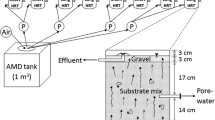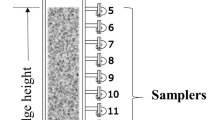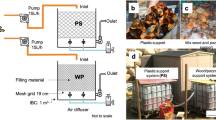Abstract
The combined treatment of acid mine drainage (AMD) and municipal wastewater using the activated sludge process is an innovative approach to AMD remediation. The toxicity of synthetic AMD to activated sludge was evaluated using oxygen uptake rate (OUR) inhibition tests, which showed that activated sludge can withstand high proportions of AMD (EC50 19–52% AMD by volume). The EC50 values of municipal and industrial activated sludges were significantly different (p < 0.05), with municipal sludges exhibiting higher tolerance to AMD. Although the EC50 values for heterotrophic and nitrifying activated sludges were not statistically significantly different, the EC50 values for heterotrophic bacteria were generally higher. Laboratory-based sequencing batch reactors were used to examine the treatability of AMD. Increased concentrations of COD and suspended solids, associated with turbidity and poor floc morphology, were observed in the final effluent after extended AMD loading. Protozoan community structure changed during the AMD loading period, and overall abundance tended to decrease over time. OUR decreased in the AMD-loaded reactors, particularly in the reactor receiving the highest AMD load, indicating reduced biomass activity over the acclimatization period. Results from OUR inhibition tests on the acclimatized activated sludge indicated that over a relatively short timescale (21 days), the activated sludge microbial community can adapt to AMD sufficiently so that shock loads of metals and acidity do not significantly inhibit OUR. These preliminary studies indicate that it is possible to treat AMD successfully in admixture with municipal wastewater using the activated sludge process.
Zusammenfassung
Die gemeinsame Behandlung von saurem Grubenwasser und kommunalem Abwasser durch das Belebtschlammverfahren ist ein innovativer Ansatz in der Grubenwasseraufbereitung. Um die Toxizität des synthetischen sauren Grubenwassers. Auf den Belebtschlamm zu untersuchen, wurde die Hemmung der Sauerstoffaufnahmerate gemessen. Wie das Ergebnis zeigt, verträgt der Belebtschlamm große Mengen an saurem Grubenwasser (EC50: 19–52 vol% saures Grubenwasser). Die EC50 Werte kommunaler und industrieller Belebtschlämme waren signifikant unerschiedlich, wobei kommunaler Schlamm toleranter auf saures Grubenwasser reagiert. Obwohl die EC50 Werte für heterotrophe und nitrifizierende Aktivschlämme statistisch nicht signifikant voneinander abweichen, waren die EC50 Werte für heterotrophe Bakterien im Allgemeinen höher. Mit Hilfe von Batch-Tests im Labormaßstab wurde untersucht, ob sich das Grubenwasser aufbereiten läßt. Nach anhaltender Zugabe von saurem Grubenwasser wurden im Ablauf erhöhte Konzentrationen an CSB und Filterrückstand beobachtet. Dies ging einher mit erhöhter Trübung und schlechter Flockungseigenschaft. Die Zusammensetzung der Protozoen-Gesellschaft veränderte sich während der Zugabe des sauren Grubenwassers und deren Menge verringerte sich im Laufe der Zeit. Insbesondere in dem Reaktor mit der höchsten Belastung an saurem Grubenwasser sank die Sauerstoffaufnahmerate. Dies kann als Hinweis auf eine erniedrigte Aktivität der Biomasse während der Anpassungszeit gesehen werden. Wie die Ergebnisse des Sauerstoffaufnahmetests an dem angepassten Belebtschlamm zeigen, kann sich die mikrobielle Gesellschaft innerhalb einer relative kurzen Zeit (21 Tage) so gut an das Grubenwasser anpassen, das seine kurzzeitige hohe Metall- und Aziditätsfracht die Sauerstoffaufhamerate nicht significant hemmt. Diese vorläufigen Untersuchungen deuten darauf hin, dass es möglich sein sollte, mit dem Belebtschlammverfahren saures Grubenwasser unter Beigabe von kommunalem Abwasser erfolgreich aufzubereiten.
Resúmen
El tratamiento combinado del drenaje de agua de mina (AMD) y las aguas residuales municipales usando el proceso de barros activados, es una aproximación innovadora a la remediación de AMD. La toxicidad de AMD sintético en los barros activados fue evaluada usando ensayos de inhibición de la velocidad de consumo de oxígeno (OUR), mostrando que los barros activados pueden resistir altas proporciones de AMD (EC50 19–52% AMD por volumen). Los valores de EC50 de barros activados municipales e industriales fueron significativamente diferentes (p < 0.05), siendo los primeros más tolerantes al AMD. Aunque los valores de EC50 para barros activados heterotróficos y nitrificantes no fueron estadísticamente diferentes, los valores de EC50 para bacterias heterotróficas fueron generalmente mayores. Se utilizaron reactores batch para examinar la tratabilidad de los AMD. El incremento de las concentraciones de COD y de sólidos suspendidos, asociados con turbidez y una pobre morfología floc, fueron observados en el efluente final después de la carga continua de AMD. La estructura de la comunidad de protozoarios cambió durante el período de carga de AMD, y la abundancia global tendió a decrecer. El OUR decreció en los reactores cargados con AMD particularmente en el reactor que recibió la máxima carga de AMD, indicando la reducción de la actividad de la biomasa durante el período de aclimatización. Los resultados de nuestros ensayos de inhibición de OUR sobre barros activados aclimatizados indicaron que en un tiempo relativamente corto (21 d), la comunidad microbiana de los barros activados puede adaptarse lo suficiente al AMD para que la carga metálica y la acidez del AMD no cause una inhibición significativa del OUR. Estos estudios preliminares indican que debería ser posible tratar los AMD exitosamente usado en procesos de barros activados conjuntamente con aguas residuales.
摘要
利用活性污泥联合处理酸性矿山废水(AMD)和城市生活污水(MWW)是实现酸性矿山废水处理的一种新方法。本文通过氧吸收率(OUR)抑制试验,研究了人工模拟合成酸性矿山废水对活性污泥的毒理,试验结果表明:活性污泥能够承受较高浓度的酸性矿山废水(EC50,即当氧吸收率的抑制比为50%时的酸性矿山废水有效体积浓度,可达19–52%)。城市和工业活性污泥的EC50 值明显不同(p < 0.05%),城市污泥对酸性矿山废水显示出更高的耐受性。虽然异养、硝化的活性污泥的EC50值也无显著差异,但是异养菌的EC50值普遍较高。研究通过实验室顺序批次试验评价了酸性矿山废水的可处理能力。在增大矿山废水负荷之后,废水处理后出流物中的COD和悬浮物浓度呈增加趋势,同时还伴随浊度增大、絮状物形态不佳等现象。 随着矿山废水负荷的增大,原生动物群落结构发生了改变,群落总体数量也随之减小。在加入酸性矿山废水负荷之后,反应装置中氧吸收率降低,尤其在酸性矿山废水负荷达最大时,反应装置中的氧吸收率降低尤为明显,表明反应装置中的生物在适应试验中数量已经减少。适应性活性污泥的氧吸收率抑制试验结果表明,即使在相对较短的时间内(21天),活性污泥的生物群落仍能够充分适应酸性矿山废水环境,金属和酸性等毒性负荷的突然增加也不至于明显抑制氧吸收率。上述基础研究表明:利用活性污泥联合处理城市污水和酸性矿山废水可以成功实现酸性矿山废水的处理。






Similar content being viewed by others
Abbreviations
- AMD:
-
Acid mine drainage
- ATU:
-
Allyl thiourea
- BOD:
-
Biochemical oxygen demand
- COD:
-
Chemical oxygen demand
- EC50 :
-
Effective concentration causing 50% inhibition
- EPS:
-
Extracellular polymeric substances
- MLSS:
-
Mixed liquor suspended solids
- MWW:
-
Municipal wastewater
- OUR:
-
Oxygen uptake rate
- OURmax :
-
Maximum oxygen uptake rate
- SVI:
-
Sludge volume index
- TSS:
-
Total suspended solids
- WWTP:
-
Wastewater treatment plant
References
Abraham JV, Butler RD, Sigee DC (1997) Ciliate populations and metals in an activated-sludge plant. Water Res 31:1103–1111
Alkan U, Eleren S, Nalbur B, Odabaş E (2008) Influence of the activated sludge system configuration on heavy metal toxicity reduction. World J Microb Biot 24:1435–1443
Aragón C, Coello MD, Quiroga JM (2010) Effect of manganese(II) on the respiratory activity of biological sludge from wastewater treatment plant. Chem Eng Res Des 88:641–646
Arican B, Yetis U (2003) Nickel sorption by acclimatized activated sludge culture. Water Res 37:3508–3516
Battistoni P, Fava G, Ruello ML (1993) Heavy metal shock load in activated sludge uptake and toxic effects. Water Res 27:821–827
Beyenal NY, Özbelge (Baser) TA, Özbelge HÖ (1997) Combined effects of Cu2+ and Zn2+ on activated sludge process. Water Res 31:699–704
Blum DJW, Speece RE (1992) The toxicity of organic chemicals to treatment processes. Water Sci Technol 25:23–31
Brown MJ, Lester JN (1979) Metal removal in activated sludge: the role of bacterial extracellular polymers. Water Res 13:817–837
Burgess JE, Stuetz RM (2002) Activated sludge for the treatment of sulphur-rich wastewaters. Miner Eng 15:839–846
Cabrero A, Fernandez S, Mirada F, Garcia J (1998) Effects of copper and zinc on the activated sludge bacteria growth kinetics. Water Res 32:1335–1362
Çeçen F, Semerci N, Geyik A (2010) Inhibition of respiration and distribution of Cd, Pb, Hg, Ag and Cr species in a nitrifying sludge. J Hazard Mater 178:619–627
Chang W-C, Hsu C-H, Chiang S-M, Su M-C (2007) Equilibrium and kinetics of metal biosorption by sludge from a biological nutrient removal system. Environ Technol 28:453–462
Cheng MH, Patterson JW, Minear RA (1975) Heavy metals uptake by activated sludge. J Water Pollut Control 47:362–376
Christofi N, Dalzell DJB, Hoffmann CC, Sales D, Morton J, Arretxe M, Heap M, Obst U, Alte S, Etxebarria J, de las Fuentes M, Gutiérrez M, De la Sota A, Aspichueta E (2000) DTOX—direct toxicity assessment of complex industrial effluents discharged to sewer. Final Report to the European Commission, Brussels, for a project funded under the Standards, Measurements and Testing Programme, contract SMT4-CT96–2084
Christofi N, Aspichueta E, Dalzell DJB, De la Sota A, Etxebarria J, Fernandes T, Gutiérrez M, Morton J, Obst U, Schmellenkamp P (2003) Congruence in the performance of model nitrifying activated sludge plants located in Germany, Scotland and Spain. Water Res 37:177–187
Chua H, Yu PHF, Sin SN, Cheung MWL (1999) Sub-lethal effects of heavy metals on activated sludge microorganisms. Chemosphere 39:2681–2692
Code of Federal Regulations (CFR) (2006) Secondary treatment regulation. 40 CFR §133.102(c), US Government Printing Office, Washington, DC, USA
Curds CR, Cockburn A (1970) Protozoa in biological sewage-treatment processes—I. a survey of the protozoan fauna of British percolating filters and activated-sludge plants. Water Res 4:225–236
Dalzell DJB, Christofi N (2002) An ATP luminescence method for direct toxicity assessment of pollutants impacting on the activated sewage sludge process. Water Res 36:1492–1502
Dubber D, Gray NF (2009) Enumeration of protozoan ciliates in activated sludge: determination of replicate number using probability. Water Res 43:3443–3452
Eaton AD, Clesceri L, Rice E, Greenberg A, Franson M (2005) Standard methods for the examination of water and wastewater, 21st edn. American Public Health Assoc, American Water Works Assoc, Water Environment Federation, Washington
Ekama GA, Wentzel MC (2008) Organic material removal. In: Henze M, Van Loosdrecht MCM, Ekama GA, Brdjanovic D (eds) Biological wastewater treatment: principles, modelling, and design. IWA Publication, London
Gernaey K, Maffei D, Vanrolleghem P, Verstraete W (1999) A new pH-based procedure to model toxic effects on nitrifiers in activated sludge. J Chem Technol Biotechnol 74:679–687
Gikas P (2008) Single and combined effects of nickel (Ni(II)) and cobalt (Co(II)) ions on activated sludge and on other aerobic microorganisms: a review. J Hazard Mater 159:187–203
Gray NF, O’Neill C (1995) Artificial acid mine drainage for use in laboratory simulation studies. Fresenius Environ Bull 4:481–484
Guibaud G, Tixier N, Bouju A, Baudu M (2003) Relation between extracellular polymers’ composition and its ability to complex Cd, Cu, and Pb. Chemosphere 52:1701–1710
Guibaud G, Comte S, Bordas F, Dupuy S, Baudu M (2005) Comparison of the complexation potential of extracellular polymeric substances (EPS), extracted from activated sludges and produced by pure bacteria strains, for cadmium, lead, and nickel. Chemosphere 59:629–638
Gutiérrez M, Etxebarria J, de las Fuentes L (2002) Evaluation of wastewater toxicity: comparative study between Microtox® and activated sludge oxygen uptake inhibition. Water Res 36:919–924
HACH Company (2007) Oxygen demand, chemical. USEPA reactor digestion method: method 8000. DOC 316.53.01099, accessible at: http://www.hach.com/asset-get.download-en.jsa?id=7639983816
Jefferson B, Burgess JE, Pichon A, Harkness J, Judd SJ (2001) Nutrient addition to enhance biological treatment of greywater. Water Res 35:2702–2710
Jenkins D, Richard MG, Daigger GT (2004) Manual on the causes and control of activated sludge bulking, foaming, and other solids separation problems, 3rd edn. CRC Press, Boca Raton
Jin B, Wilén B-M, Lant P (2003) A comprehensive insight into floc characteristics and their impact on compressibility and settleability of activated sludge. Chem Eng J 95:221–234
Johnson KL, Younger PL (2006) The co-treatment of sewage and mine waters in aerobic wetlands. Eng Geol 85:53–61
Juliastuti SR, Baeyens J, Creemers C, Bixio D, Lodewyckx E (2003) The inhibitory effects of heavy metals and organic compounds on the net maximum specific growth rate of the autotrophic biomass in activated sludge. J Hazard Mater B100:271–283
Katsou E, Malamis S, Loizidou M (2011) Performance of a membrane bioreactor used for the treatment of wastewater contaminated with heavy metals. Bioresour Technol 102:4325–4332
Kelly CJ, Tumsaroj N, Lajoie CA (2004) Assessing wastewater metal toxicity with bacterial bioluminescence in a bench-scale wastewater treatment system. Water Res 38:423–431
Kilroy AC, Gray NF (1992) The toxicity of four organic solvents commonly used in the pharmaceutical industry to activated sludge. Water Res 26:887–892
Kunz A, Jardim WF (2000) Complexation and adsorption of copper in raw sewage. Water Res 34:2061–2068
Love NG, Bott CB (2000) A review and needs survey of upset early warning devices. Water Environment Research Foundation, Alexandria
Madoni P, Davoli D, Gorbi G, Vescovi L (1996) Toxic effect of heavy metals on the activated sludge protozoan community. Water Res 30:135–141
Madoni P, Davoli D, Guglielmi L (1999) Response of SOUR and AUR to heavy metal contamination in activated sludge. Water Res 33:2459–2464
Neto RR, Crocetta MS, Souza MGR, Rocha E, Zanuz M, Gomes CJB (2010) Combined treatment of acid mine drainage and sewage in the state of Santa Catarina—Brazil. In: Wolkersdorfer C, Freund A (eds) Proc, mine water and innovative thinking. International Mine Water Assoc (IMWA), Sydney, pp 183–186
Neufeld RD (1976) Heavy metals induced deflocculation of activated sludge. J Water Pollut Control Fed 48:1940–1947
Neufeld RD, Hermann ER (1975) Heavy metal removal by acclimated activated sludge. J Water Pollut Control Fed 47:310–329
Nicolau A, Mota M, Lima N (1999) Physiological responses of Tetrahymena pyriformis to copper, zinc, cycloheximide and Triton X-100. FEMS Microbiol Ecol 30:209–216
Nicolau A, Martins MJ, Mota M, Lima N (2005) Effect of copper in the protistan community of activated sludge. Chemosphere 58:605–614
OECD (1984) OECD guidelines for testing of chemicals, method 209: activated sludge, respiration inhibition test. Organization for Economic Co-Operation and Development, Paris
OECD (2010) OECD guidelines for testing of chemicals, section 2: effects on biotic systems, test no. 209: activated sludge, respiration inhibition test (carbon and ammonium oxidation). Organization for Economic Co-Operation and Development, Paris
Omoike AI, Vanloon GW (1999) Removal of phosphorus and organic matter removal by alum during wastewater treatment. Water Res 33:3617–3627
Ong SA, Lim PE, Seng CE (2003) Effects of adsorbents and copper(II) on activated sludge microorganisms and sequencing batch reactor treatment process. J Hazard Mater B 103:263–277
Ong SA, Toorisaka E, Hirata M, Hano T (2004) Effects of Ni(II) addition on the activity of activated sludge microorganisms and activated sludge process. J Hazard Mater B 113:111–121
Ong SA, Toorisaka E, Hirata M, Hano T (2005) The behavior of Ni(II), Cr(III), and Zn(II) in biological wastewater treatment processes. Acta Hydrochim Hydrobiol 33:95–103
Özbelge TA, Özbelge HÖ, Altinten P (2007) Effect of acclimatization of microorganisms to heavy metals on the performance of activated sludge process. J Hazard Mater 142:332–339
Pagnanelli F, Mainelli S, Bornoroni L, Dionisi D, Toro L (2009) Mechanisms of heavy-metal removal by activated sludge. Chemosphere 75(8):1028–1034
Pai TY, Wang SC, Lo HM, Chiang CF, Liu MH, Chiou RJ, Chen WY, Hung PS, Liao WC, Leu HG (2009) Novel modeling concept for evaluating the effects of cadmium and copper on heterotrophic growth and lysis rates in activated sludge process. J Hazard Mater 166:200–206
Pambrun V, Marquot A, Racault Y (2008) Characterization of the toxic effects of cadmium and 3,5-dichlorophenol on nitrifying activity and mortality in biologically activated sludge systems—effect of low temperature. Environ Sci Pollut Res 15:592–599
Pamukoglu MY, Kargi F (2009) Removal of Cu(II) ions by biosorption onto powdered waste sludge (PWS) prior to biological treatment in an activated sludge unit: a statistical design approach. Bioresour Technol 100:2348–2354
Principi P, Villa F, Bernasconi M, Zanardini E (2006) Metal toxicity in municipal wastewater activated sludge investigated by multivariate analysis and in situ hybridization. Water Res 40:99–106
Rao SR, Gehr R, Riendeau M, Lu D, Finch JA (1992) Acid mine drainage as a coagulant. Miner Eng 5:1011–1020
Santos A, Judd S (2010) The fate of metals in wastewater treated by the activated sludge process and membrane bioreactors: a brief review. J Environ Monit 12:110–118
Sher MI, Arbuckle WB, Shen Z (2000) Oxygen uptake rate inhibition with PACT™ sludge. J Hazard Mater B73:129–142
Sibrell PL, Montgomery GA, Ritenour KL, Tucker TW (2009) Removal of phosphorus from agricultural wastewaters using adsorption media prepared from acid mine drainage sludge. Water Res 43:2240–2250
Sorour MT, Sayed-Ahmed AM (2005) Combined effects of cadmium and zinc on both sequencing batch reactor and continuous activated sludge. Environ Technol 26:963–974
Spanjers H, Vanrolleghem PA, Olsson G, Dold PL (1998) Respirometry in control of the activated sludge process: principles. IAWQ scientific and technical report. IAWQ, London
Stasinakis AS, Thomaidis NS, Mamais D, Papanikolaou EC, Tsakon A, Lekkas TD (2003) Effects of chromium(VI) addition on the activated sludge process. Water Res 37:2140–2148
Sterritt RM, Lester JN (1984) Significance and behaviour of heavy metals in waste water treatment processes: III. Speciation in waste waters and related complex matrices. Sci Total Environ 34:117–141
Sterritt RM, Brown MJ, Lester JN (1981) Metal removal by adsorption and precipitation in the activated sludge process. Environ Pollut Ser A 24:313–323
Strosnider WH, Winfrey BK, Nairn RW (2011a) Novel passive co-treatment of acid mine drainage and municipal wastewater. J Environ Qual 40:206–213
Strosnider WH, Winfrey BK, Nairn RW (2011b) Biochemical oxygen demand and nutrient processing in a novel multi-stage raw municipal wastewater and acid mine drainage passive co-treatment system. Water Res 45:1079–1086
Strosnider WH, Winfrey BK, Nairn RW (2011c) Alkalinity generation in a novel multi-stage high-strength acid mine drainage and municipal wastewater passive co-treatment system. Mine Water Environ 30:47–53
Wang L, Liu Y, Li J, Liu X, Dai R, Zhang Y, Zhang S, Li J (2010) Effects of Ni2+ on the characteristics of bulking activated sludge. J Hazard Mater 181:460–467
Wei X, Viadero RC Jr, Bhojappa S (2008) Phosphorus removal by acid mine drainage sludge from secondary effluents of municipal wastewater treatment plants. Water Res 42:3275–3284
Winfrey BK, Strosnider WH, Nairn RW, Strevett KA (2010) Highly effective reduction of fecal indicator bacteria counts in an ecologically engineered municipal wastewater and acid mine drainage passive co-treatment system. Ecol Eng 36:1620–1626
Xie B, Nakamura E (2002) Shock effects of copper ion on activated sludge unacclimated and its recovery technique. Toxicol Environ Chem 83:55–67
Yetis U, Gokcay CF (1989) Effect of nickel(II) on activated sludge. Water Res 23:1003–1007
You S-J, Tsai Y-P, Huang R-Y (2009) Effect of heavy metals on nitrification performance in different activated sludge processes. J Hazard Mater 165:987–994
Acknowledgments
T.A. Hughes gratefully acknowledges the support provided by the Irish Research Council for Science, Engineering, and Technology (IRCSET) Embark Initiative and Science Foundation Ireland (SFI) (grant 08/rfp/enm993). In addition, T.A. Hughes extends sincere appreciation to the personnel at Leixlip, Swords, and Kilcoole WWTPs.
Author information
Authors and Affiliations
Corresponding author
Rights and permissions
About this article
Cite this article
Hughes, T.A., Gray, N.F. Acute and Chronic Toxicity of Acid Mine Drainage to the Activated Sludge Process. Mine Water Environ 31, 40–52 (2012). https://doi.org/10.1007/s10230-011-0168-y
Received:
Accepted:
Published:
Issue Date:
DOI: https://doi.org/10.1007/s10230-011-0168-y




